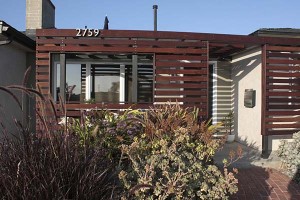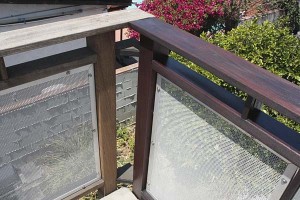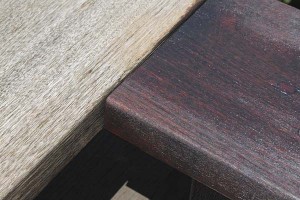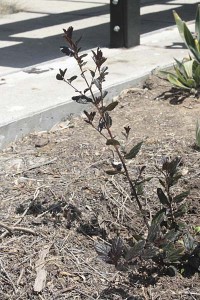I showed the almost-complete version of this front porch screen earlier, but that was before we applied the final stain to the wood. Here it is in the really final version.
As long as we were staining wood, we got up to the deck and attacked the railings with the same stain. It had been more than a year since we’d done it last and things had faded. You can see the before and after pretty clearly in these pictures. (This project used an oil-based stain for hardwoods. They make a water-based stain that claims to last seven years, but it ended up flaking off this oily ipe hardwood on the small project we tested it on. Total disaster. Save it for softwoods.)
How do all of you react to exterior wood that’s aged to a silver color? This project is still on the new side for us and we wanted to keep it looking as it did when we first finished it. Staining all the tops and bottoms and sides of the wood is a lot of work, though. As we get less able or motivated to keep up with details around the house, I’m sure we’ll let things assume more of a Gray Gardens look.
But back to the front screen… After the project was complete there was a gap between where the screen ends and the driveway. While I’m not one to put up castle walls and a moat between us and the busy street, a little more privacy seemed like a good idea.
Before, we had a couple low lavenders in front of the screen: Nice enough and they survived with virtually no summer watering. But they weren’t much of a privacy screen. Yank. Out they went.
In their place is this new Ceanothus ‘Tuxedo.’ I’d done a post on some garden ceanothus not long ago, and I couldn’t stop thinking about the near-black foliage of this variety. With the lavenders gone, there was a perfect place for it.
Okay, stare at the picture of the little gallon plant and ask the obvious question: “Wasn’t the idea to install a plant that would screen the view from the street?”
Ceanothus tend to be rapid growers. This selection is new to the trade this spring, so I’m not sure exactly how rapid it’ll be. Still, I expect that it’ll approach its target size of six feet by six feet before too long. I’ll post more pictures as it fills in.






I don’t mind silvery fences that are supposed to recede into the background, but I think stained wood always looks nicer, especially for projects like this that are a prominent part of the house’s appearance. It looks gorgeous, and I imagine it keeps the porch a lot cooler and more comfortable.
Hey James, I have a busy street in front of my house and I kind of hate to admit, but want castle rock walls in between my house and the street! Yup, we all need our space and privacy and noise reduction. I think the ceonanthus will be lovely. It looks as though it will blend in with the wood fairly well and give you privacy.
We’ll want to see that ceanothus after the first winter! I’ll be curious how big it gets. Does seem to be a very cool plant. Lavender is past its prime after a few years anyway.
Gayle, we do have some runs fences around the house that we’ve let go gray. With plants in front, you really don’t notice them.
Tina, the house is about 3 1/2 feet above street level and a lot of the road noise bounces off the wall, so from a noise standpoint it’s not so bad. The people on the other side are on the flats, and a lot of them have walls to block the noise and shrubs to preserve their privacy.
Town Mouse, I do worry a bit about eventual size, but I do own a few pairs of clippers. I’ve often let the mature projected plant size keep me from planting and enjoying a lot of larger plants that could be kept under control with a little pruning. I really should rethink how I plant.
Greetings from the Land of Weathered Gray Cedar Shingles! I think your stain-job looks lovely, so kudos for the hard work. Isn’t there some kind of sealant that might preserve the color a little longer? I’m probably just naive on the subject.
No more lavendar?! Sigh. And here I am, longing to stay in one place long enough to properly grow some. The grass…and other plants…really is greener, isn’t it? : )
Greg, 15 years with the same lavender plants was probably a good run. If I start pining for them I’ve already noticed some seedlings coming back around where the parents were. As far as the stain issue, I think all of you in the LoWGCS have developed a great low-maintenance look that doesn’t require all this outdoor toil and trouble. There are 10+ year stains that work great on cedar and pine and other softwoods, but this hardwood is so oily those stains just flake off.
I am really delighted to see you have planted our Ceanothus Tuxedo in your garden. You have no idea how deligthed I was to come on your blog featuring my plant. I discovered it in 1999 and was able to root one cutting out of 3 stuck. The original plant I found it on died and it took me another 5 years to nurse some more cuttings along until I had 9 plants in 2003 from that I got the trick of how to root this very dark plant and was able to ship some plants under USDA permit to California. now the plant is there and thriving by all accounts. Again thank you for this verification its made it to a private garden ther eI am really pleased.
Kind regards
Patrick J FitzGerald
Patrick, I’m honored to have had you stop by my blog! I’m glad you saw the potential in the mutation, and that at least one of the starts made it. It would have been sad if it had ended being the one that got away. I’m looking forward to watching the plant grow and take its place of honor at the front of my home!
Can you tell me where I can get the new ceanothus tuxedo? I am in the LA area, but travel quite often between San Luis Obispo and San Diego. Thanks,
Helen
Helen, in San Diego I’ve seen them at Walter Anderson Nursery, in the Point Loma area, and for only a very brief time at the chain Armstrong Garden Centers. Summer is a spotty season as far as availability, so I’d recommend calling first. They’re distributed in the US by Native Sons in Arroyo Grande, and I’d guess that a good nursery near you might be able to special order it for you without your having to make the trip down here. The recent Native Sons listing showed them as available in the 1 gallon size.
I’m not sure if this string of comments is still being monitored, by I’d be interested in learning more about the design and material that went into your porch railing. It has a great mix of modern and traditional which is exactly what I’m hoping to use on a new deck I built this year. Thanks!
Hi Michael,
The wood we used for the structural frame on the deck is ipe, which at the time of construction was about half the cost of teak. It’s incredibly dense wood and a challenge to work with–you have to pre-drill everything. But it’s really attractive and is supposed to be termite- and fire-resistant. The infill panels are made of perforated aluminum sheet with 1-inch aluminum angle frames. It’s all held together with stainless screws and bolts and rubber washers to isolate the two metals so they don’t touch and cause each other to degrade. Short lengths of the angle aluminum serve to reinforce the corners. If you’ve never worked with aluminum, it cuts and drills okay with carbide-tipped hand tools, although I had the metal supply place cut the infill sheets for me. I hope that helps!
That helps a ton! I’ve never worked with Ipe so I appreciate the tip about pre-drilling everything. Thanks so much.